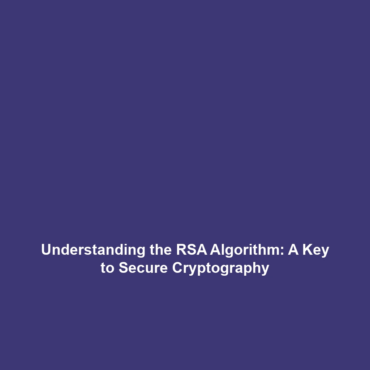Understanding the RSA Algorithm in Cryptography
The RSA Algorithm is a cornerstone of modern cryptography, providing secure data transmission through asymmetric encryption. As digital communication continues to grow, the significance of RSA in safeguarding sensitive information cannot be overstated. This article delves into the fundamental principles behind the RSA Algorithm, its applications, current challenges, and future directions within the realm of cryptography.
Key Concepts of RSA Algorithm
At its core, the RSA Algorithm operates based on a few key concepts that are crucial to understanding its role in cryptography:
Asymmetric Encryption
RSA utilizes asymmetric encryption, meaning it employs two different keys—a public key for encryption and a private key for decryption. This foundational principle enhances security in cryptographic practices.
Mathematics Behind RSA
The algorithm is predicated on the mathematical difficulty of factoring large integers. RSA leverages prime factorization, which is computationally challenging, to secure data transmission.
Digital Signatures
RSA is also pivotal for creating digital signatures, ensuring data integrity and authenticity by encrypting hash values of messages.
Applications and Real-World Uses
The RSA Algorithm finds extensive application across various fields due to its robust security features. Here are some of the critical applications:
- Secure Communication: RSA is widely used in secure email services to encrypt messages, ensuring only intended recipients can read them.
- Web Security: RSA plays a crucial role in securing HTTPS connections, protecting data transmitted over the internet.
- Cryptographic Tokens: RSA is involved in generating secure tokens for authentication, commonly utilized by financial institutions and online platforms.
Current Challenges of RSA Algorithm
Despite its widespread use, the RSA Algorithm encounters several challenges and limitations:
- Computational Load: RSA encryption and decryption processes are resource-intensive, particularly with large key sizes.
- Vulnerability to Quantum Computers: The advent of quantum computing poses a significant threat to RSA’s security, prompting researchers to explore quantum-resistant algorithms.
- Key Management: The difficulty of securely generating and managing keys can lead to vulnerabilities if not properly addressed.
Future Research and Innovations
Looking ahead, ongoing research into the RSA Algorithm is focused on addressing its limitations and enhancing its applications. Innovations in cryptographic techniques, such as:
- Post-Quantum Cryptography: Researchers are developing new cryptographic systems to resist quantum attacks, which could surpass existing RSA security measures.
- Hybrid Encryption Systems: Combining RSA with other algorithms to create more efficient encryption solutions is an area of active exploration.
Conclusion
In summary, the RSA Algorithm plays a vital role in the field of cryptography, underpinning various secure communication methods and applications. Understanding its principles, applications, and challenges is essential for anyone interested in the future of data security. To learn more about related topics, consider exploring our pages on Asymmetric Encryption and The Future of Cryptography.
